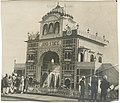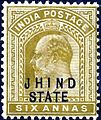Jind State

| Jind & Sangrur State | |||||||||||
|---|---|---|---|---|---|---|---|---|---|---|---|
| Princely State of British India (1809–1948) | |||||||||||
| 1763–20 August 1948 | |||||||||||
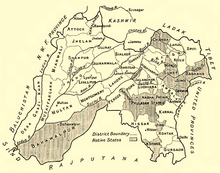 Jind State in a 1911 map of Punjab | |||||||||||
| Capital | Sangrur | ||||||||||
| Area | |||||||||||
• 1931 | 3,460 km2 (1,340 sq mi) | ||||||||||
| Population | |||||||||||
• 1931 | 324,676 | ||||||||||
| History | |||||||||||
• Established | 1763 | ||||||||||
| 20 August 1948 | |||||||||||
| |||||||||||
| Today part of | India | ||||||||||
Jind State (also spelled Jhind State) was a princely state located in the Punjab and Haryana region of north-western India. The state was 3,260 km2 (1,260 sq mi) in area and its annual income was Rs.3,000,000 in the 1940s.[1] Jind was founded and ruled by Jat Sikh rulers of Sidhu clan.[2]
Location
[edit]The area of the state was 1259 square miles in total and it ranged from Dadri, Karnal, Safidon, and Sangrur.[1][3]
History
[edit]Origin
[edit]The ruling house of Jind belonged to the Phulkian dynasty, sharing a common ancestor named Tiloka with the Nabha rulers. Tiloka was the eldest son of Phul Sidhu of the Phulkian Misl.[3] The Jind rulers descend from Sukhchain Singh, the younger son of Tiloka.[4] The Jind State was founded in 1763 by Gajpat Singh after the fall of Sirhind.[3] Other sources give a date of 1768 for the founding of the state.[1]
Gajpat Singh, son of Sukhchain Singh and great-grandson of Phul, launched a rebellion against the hostile authority based out of Sirhind.[1] The rebellion was a Sikh coalition against the Afghan governors of Jind State.[3] As a reward, Gajpat received a large tract of land, which included Jind and Safidon.[3] Gajpat established his headquarters at Jind, building a large, brick fort in the location.[3]

He established the state in 1763 or 1768 and made Sangrur its capital.[1][3] Gajpat was bestowed with the title of Raja by the Mughal emperoer Shah Alam in the year 1772.[1][3] As a mark of sovereignty, the Sikh raja minted coins bearing his name.[1][3] Shortly after being bestowed with the raja title by the Mughals, Jind was attacked by Rahim Dad Khan, the governor of Hansi, but he was killed-in-action.[3] In 1774, a dispute arose between Jind and Nabha states.[3] The precarious intra-Phulkian situation led to Gajpat Singh of Jind sending troops against Hamir Singh of Nabha, with the former taking possessions of Imloh, Bhadson, and Sangrur from the latter's control.[3] However, the ruler of Patiala State and influential members of the family led to Imloh and Bhadson being returned back to Jind's rule.[3] Sangrur remained with Jind and was not given back to Nabha.[3] A daughter of Gajpat Singh of Jind married Mahan Singh of the Sukerchakia Misl and was the mother of Ranjit Singh.[3]
Gajpat Singh ordered the raising of several fortresses, whom were constructed using lakhauri (thin burnt-clay) bricks in the year 1775.[1] One of the forts was built to the left of the present-day Rani Talab and the second was built to the right of present-day Tanga Chowk.[1] There was a family connection shared between Jind State and the Sukerchakia Misl, due to the fact that Gajpat's daughter, Raj Kaur, was the mother of Maharaja Ranjit Singh whom founded the Sikh Empire.[1]
Gajpat Singh died in 1786.[3]
After the passing of Gajpat, his son Bhag Singh succeeded to the throne of Jind in 1789.[1] Bhag Singh is notable as being the first cis-Sutlej or Phulkian Sikh ruler to develop amicable ties with the British East India Company, which developed into a state of allyship between the two parties.[1]
British era
[edit]
It was part of the Cis-Sutlej states[citation needed] until 25 April 1809, when it became a British protectorate.[5] After Bhag Singh died, he would be succeeded by Fateh Singh, who in-turn was followed by Sangat Singh.[1] After the death of Sangat Singh, the throne went to his cousin, Swarup Singh.[1] Then the throne passed to Swarup's son, Raghubir Singh.[1] Raghubir Singh did produce an immediate heir in the form of a son named Balbir Singh, but his son had died while young so the line of succession passed to his grandson, Ranbir Singh, who is described as a "philanderer, an extravagant and a philanthropist".[1] Ranbir is noted for being the longest reigning ruler of the Phulkian dynasty.[1] He had twelve children born from his four wives.[1]
Indian painter Sita Ram produced watercolours of the local scenery (landscape and architecture) of Jind State between June 1814 to early October 1815.[6]
During the First World War, the Jind Imperial Service Regiment saw conflict.[1] The state was awarded with a fifteen-gun salute.[1]
On 20 August 1948, with the signing of the instrument of accession, Jind became a part of the Patiala and East Punjab States Union of the newly independent India on 15 July 1948.[1]
Postage stamps prior to King George V consisted of Indian stamps over printed as "Jhind State", with the letter 'H' in the name. On the George V stamps, the 'H' is omitted and is overprinted as "Jind State" (Reference actual stamps from the Victorian, Edward VII and George V eras).
Post-independence
[edit]Ranbir Singh died on 31 March 1948, shortly after he signed the instrument of accession.[1] He was succeeded by his son Rajbir Singh.[1] Rajbir died in 1959 and in-turn was succeeded by his brother named Jagatbir Singh.[1] However, Rajbir's son named Satbir Singh, claims to have been crowned as a successor to his father, leading to a dispute between the brother and son of the late Rajbir.[1]
After the division of Punjab in 1966, the former territories of Jind State were given to the then newly formed state of Haryana.[1] Thus, Jind town and district now form a part of Indian state of Haryana.
The family of the former Jind rulers are mired in family divisions and conflicts over shares of their declining wealth.[1] The Jind royals currently reside at Raja ki Kothi on Amarhedi Road.[1]
Economy
[edit]The revenue per annum of Jind State was around 2,800,000 rupees.[3]
Heritage conservation
[edit]Many monuments and structures related to the erstwhile Jind state lie in disrepair and disregard and few efforts are being taken to conserve them, in-contrast to the heritage of Patiala and Nabha states.[1] Two historical forts (both constructed in 1775 and were located near Rani Talab and Tanga Chowk) related to the history of the state were demolished in the 1990s to make way for newer developments, such as shopping bazaars, a Doordarshan Relay Centre, and parks.[1] There was also a third Jind fort that was demolished in the 1990s as well, it was located beside the fort near Rani Talab.[1] The land the former forts stood on has also suffered from illegal encroachments.[1] Many historical artefacts related to the state have been looted and smuggled.[1] The city of Jind was also known for its three city-gates connected by a border wall, which were named Jhanjh Gate, Ramrai Gate, and Safidon Gate, however these gates have not survived to the present-day.[1] Efforts are ongoing to have the ASI declare the buildings of Rani Talab, Raja-Ki-Kothi, and Khunga Kothi as protected heritage sites.[1] Indo-Saracenic buildings of Jind have fallen into a decrepit condition.[1]
List of rulers
[edit]| No. | Name (Birth–Death) | Portrait | Reign | Enthronement | Ref. |
|---|---|---|---|---|---|
| Sardars | |||||
| 1 | Sukhchain Singh (1683 – 1758) | ? | ? – 1758 | ? | [4] |
| Rajas | |||||
| 2 | Gajpat Singh (15 April 1738 – 11 November 1789) | 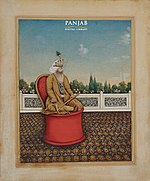 | 1758 – 1789 | ? | [7][4] |
| 3 | Bhag Singh (23 September 1760 – 16 June 1819) |  | 1789 – 1819 | November 1789 | [7][4] |
| 4 | Fateh Singh (6 May 1789 – 3 February 1822) | 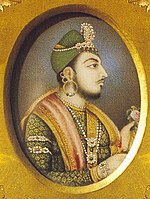 | 1819 – 1822 | ? | [7][4] |
| 5 | Sangat Singh (16 July 1810 – 4/5 November 1834) | 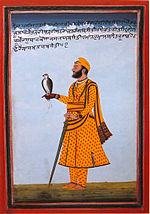 | 1822 – 1834 | 30 July 1822 | [7][4] |
| 6 | Swarup Singh (30 May 1812 – 26 January 1864) |  | 1834 – 1864 | April 1837 | [7][4] |
| 7 | Raghubir Singh (1832 – 7 March 1887) | 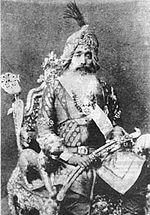 | 1864 – 1887 | 31 March 1864 | [7][4] |
| 8 | Ranbir Singh (11 October 1879 – 1 April 1948) |  | 1887 – 1948 | 27 February 1888 | [7][4][1] |
| Titular | |||||
| 9 | Rajbir Singh | 1948 – 1959 | [7][4][1] | ||
| 10 | Jagatbir Singh (disputed[1])[a] | 1959 – ? | [8][1][7] | ||
| 11 | Rambir Singh (1944 – 1992) | ? – 1992 | [1] | ||
| 12 | Gajraj Singh (1981 – 2016) | 1992 – 2016 | [1] | ||
| 13 | Jagbir Singh Sidhu (1979 – 2018) | 2016 – 2018 | [1] | ||
| 14 | Gunveer Singh (born 2014) | 2018 – present | [1] | ||
Demographics
[edit]| Religious group | 1901[9] | 1911[10][11] | 1921[12] | 1931[13] | 1941[14] | |||||
|---|---|---|---|---|---|---|---|---|---|---|
| Pop. | % | Pop. | % | Pop. | % | Pop. | % | Pop. | % | |
| Hinduism | 211,963 | 75.16% | 210,222 | 77.36% | 234,721 | 76.16% | 243,561 | 75.02% | 268,355 | 74.17% |
| Islam | 38,717 | 13.73% | 37,520 | 13.81% | 43,251 | 14.03% | 46,002 | 14.17% | 50,972 | 14.09% |
| Sikhism | 29,975 | 10.63% | 22,566 | 8.3% | 28,026 | 9.09% | 33,290 | 10.25% | 40,981 | 11.33% |
| Jainism | 1,258 | 0.45% | 1,233 | 0.45% | 1,548 | 0.5% | 1,613 | 0.5% | 1,294 | 0.36% |
| Christianity | 80 | 0.03% | 187 | 0.07% | 637 | 0.21% | 210 | 0.06% | 161 | 0.04% |
| Zoroastrianism | 0 | 0% | 0 | 0% | 0 | 0% | 0 | 0% | 3 | 0% |
| Buddhism | 0 | 0% | 0 | 0% | 0 | 0% | 0 | 0% | 3 | 0% |
| Judaism | 0 | 0% | 0 | 0% | 0 | 0% | 0 | 0% | 0 | 0% |
| Others | 10 | 0% | 0 | 0% | 0 | 0% | 0 | 0% | 43 | 0.01% |
| Total population | 282,003 | 100% | 271,728 | 100% | 308,183 | 100% | 324,676 | 100% | 361,812 | 100% |
| Note: British Punjab province era district borders are not an exact match in the present-day due to various bifurcations to district borders — which since created new districts — throughout the historic Punjab Province region during the post-independence era that have taken into account population increases. | ||||||||||
Gallery
[edit]- Raja Gajpat Singh of Jind State
- Raja Sangat Singh of Jind State
- Raja Swarup Singh of Jind State
- Miniature painting of Sardar Daya Singh Sibia of Ramgarh, revenue minister of Jind State during the reign of Maharaja Raghubir Singh
- Photograph taken in the erstwhile Jind State
- Stamp of the Jind State. Edward VII, 1905
See also
[edit]- Political integration of India
- Phulkian sardars
- Patiala State
- Nabha State
- Faridkot State
- Malaudh
- Bhadaur
- Kaithal
- Cis-Sutlej states
Notes
[edit]- ^ Rajbir's other son Satbir Singh also claims to have been coroneted.
- ^ 1931-1941: Including Ad-Dharmis
References
[edit]- ^ a b c d e f g h i j k l m n o p q r s t u v w x y z aa ab ac ad ae af ag ah ai aj ak al am an ao ap aq ar Malik, Satyawan (25 January 2020). "Jind monuments a picture of neglect". The Tribune. Archived from the original on 24 September 2023. Retrieved 9 September 2023.
- ^ Bates, Crispin (26 March 2013). Mutiny at the Margins: New Perspectives on the Indian Uprising of 1857: Volume I: Anticipations and Experiences in the Locality. SAGE Publishing India. ISBN 978-81-321-1589-2. Archived from the original on 10 February 2024. Retrieved 29 January 2023.
- ^ a b c d e f g h i j k l m n o p q Dhingra, Behari Lal (1930). Jind State: A Brief Historical and Administrative Sketch (With Some Photographs). Bombay: Time of India Press.
- ^ a b c d e f g h i j Singh, Bhagat (1993). "Chapter 14 - The Phulkian Misl". A History of the Sikh Misals. Publication Bureau, Punjabi University.
- ^ Chisholm, Hugh, ed. (1911). . Encyclopædia Britannica. Vol. 15 (11th ed.). Cambridge University Press. p. 416.
- ^ Tilak, Sudha G. (16 November 2023). "Sita Ram: The unknown Indian artist who painted for British rulers". BBC. Retrieved 23 August 2024.
- ^ a b c d e f g h i Kumar, Vijender (29 December 2018). "Jind royal family scion passes away". The Times of India. ISSN 0971-8257. Archived from the original on 7 February 2023. Retrieved 7 February 2023.
The first king of the estate was Raja Gajpat Singh who died in 1789. After that Raja Bhag Singh took charge as king in 1789 and died in 1819. Next, Raja Fateh Singh ruled from till February 3, 1822, followed by Raja Sangat Singh from July 30, 1822, to November 1834. He was followed by Raja Sarup Singh till January 1864, Raja Raghubir Singh till 1887, Maharaja Ranbir Singh till 1948 and Rajbir Singh in 1948," Bhardwaj added.
- ^ Kumar, Vijender (29 December 2018). "Jind royal family scion passes away". The Times of India. ISSN 0971-8257. Archived from the original on 7 February 2023. Retrieved 8 February 2023.
The historian said that after Rajbir Singh's death his brother Jagatbir Singh was crowned but he never ruled as after Independence all 562 princely estates merged with India. Jagatbir had one son Kunwar Rambir Singh who married present day Inder Jeet Kaur. He died in 1972 at the age of 42. Kunwar Rambir's both sons are dead now and Rani Inder Jeet Kaur holds the title.
- ^ "Census of India 1901. [Vol. 17A]. Imperial tables, I-VIII, X-XV, XVII and XVIII for the Punjab, with the native states under the political control of the Punjab Government, and for the North-west Frontier Province". 1901. p. 34. JSTOR saoa.crl.25363739. Retrieved 30 March 2024.
- ^ "Census of India 1911. Vol. 14, Punjab. Pt. 2, Tables". 1911. p. 27. JSTOR saoa.crl.25393788. Retrieved 30 March 2024.
- ^ Kaul, Harikishan (1911). "Census Of India 1911 Punjab Vol XIV Part II". p. 27. Retrieved 30 March 2024.
- ^ "Census of India 1921. Vol. 15, Punjab and Delhi. Pt. 2, Tables". 1921. p. 29. JSTOR saoa.crl.25430165. Retrieved 30 March 2024.
- ^ "Census of India 1931. Vol. 17, Punjab. Pt. 2, Tables". 1931. p. 277. JSTOR saoa.crl.25793242. Retrieved 30 March 2024.
- ^ "Census of India, 1941. Vol. 6, Punjab". 1941. p. 42. JSTOR saoa.crl.28215541. Retrieved 30 March 2024.
External links
[edit] Media related to Jind State at Wikimedia Commons
Media related to Jind State at Wikimedia Commons





